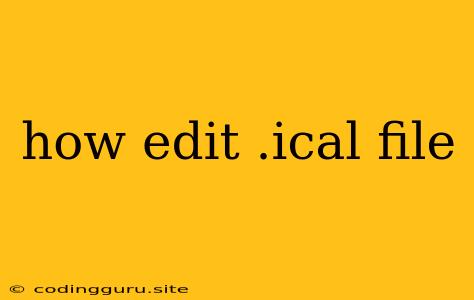How to Edit .ical Files: A Comprehensive Guide
.ical files are a common format for storing calendar events, appointments, and reminders. You might encounter them when sharing calendar data with others, importing events from online services, or simply managing your own schedule. But what if you need to modify the information within an .ical file?
This guide will walk you through the different ways you can edit .ical files, covering methods suitable for various levels of technical proficiency.
1. Editing .ical Files with a Text Editor
The most basic approach involves directly editing the .ical file's content using a text editor. This method provides granular control over the data but requires understanding the file's structure.
Here's a step-by-step breakdown:
- Open the .ical file: Use a plain text editor like Notepad (Windows), TextEdit (Mac), or a code editor like VS Code.
- Navigate to the desired event: .ical files are structured using a specific syntax. Look for the "BEGIN:VEVENT" and "END:VEVENT" lines to identify individual events.
- Modify the event details: Within the event block, you'll find various fields like:
- SUMMARY: The event's title
- DTSTART: The event's start date and time
- DTEND: The event's end date and time
- LOCATION: The event's location
- DESCRIPTION: A detailed description of the event
- RRULE: Specifies recurrence rules (e.g., weekly, monthly)
- Save the changes: Save the .ical file with the same name and extension.
Example:
Let's say you want to change the title of an event in an .ical file. You would find the event's block starting with "BEGIN:VEVENT", then modify the line containing "SUMMARY:" with the new title.
BEGIN:VEVENT
DTSTART:20240215T100000
DTEND:20240215T110000
SUMMARY:Original Event Title
...
END:VEVENT
After editing, the line would look like this:
BEGIN:VEVENT
DTSTART:20240215T100000
DTEND:20240215T110000
SUMMARY:New Event Title
...
END:VEVENT
Tip: While text editors offer precise control, this method can be challenging for beginners due to the technical syntax. Consider using dedicated calendar applications or online tools for a more user-friendly experience.
2. Editing .ical Files with Dedicated Calendar Applications
Several calendar applications, both desktop and web-based, offer support for importing and editing .ical files. This approach provides a visual interface and simplifies the process of modifying events.
Popular options include:
- Google Calendar: Import the .ical file into Google Calendar. This allows you to modify events, add new ones, and manage your schedule within a familiar interface.
- Apple Calendar: Apple Calendar on macOS and iOS devices allows you to import .ical files, making it convenient for managing calendar data across platforms.
- Microsoft Outlook: Outlook offers robust calendar features, including import capabilities for .ical files. You can edit events directly within the Outlook calendar.
- Mozilla Thunderbird: Thunderbird's Lightning extension provides a full-featured calendar experience, allowing you to work with .ical files.
Here's how to edit an .ical file using Google Calendar:
- Log in to Google Calendar: Access your Google Calendar account.
- Import the .ical file: Click the "Other calendar" dropdown menu in the left sidebar and select "Import calendar."
- Browse to the .ical file: Locate and select the .ical file you want to import.
- Edit the events: Once imported, you can edit the events using the familiar Google Calendar interface.
- Export the changes: If you need to save the edited .ical file, you can export it from Google Calendar's settings.
3. Editing .ical Files with Online Tools
Several online tools specialize in editing and converting .ical files. These services offer user-friendly interfaces, often with visual calendars, and simplify the editing process.
Popular online .ical file editors:
- icalendar.org: This service provides a free and intuitive online editor for .ical files. It allows you to modify events, add new ones, and download the updated file.
- iCal Converter: This website offers a range of options for converting .ical files to other formats and vice versa. It also provides a basic editor for making changes to events.
- icalendar.io: This web-based calendar tool allows you to import .ical files and edit their contents. You can also share calendars with others.
To edit an .ical file using icalendar.org:
- Open the icalendar.org website: Visit the icalendar.org website.
- Upload the .ical file: Click the "Upload" button and select the .ical file you want to edit.
- Modify the events: The website will display the calendar events in a list format. Click on an event to modify its details.
- Download the changes: Once you've made your changes, click the "Download" button to save the updated .ical file.
4. Editing .ical Files with Programming
For advanced users who are comfortable with scripting, you can edit .ical files using programming languages like Python. This method offers ultimate flexibility but requires programming knowledge.
Python Example:
import icalendar
# Read the .ical file
with open('calendar.ics', 'rb') as f:
cal = icalendar.Calendar.from_ical(f.read())
# Find the event to edit
for component in cal.walk():
if component.name == 'VEVENT':
if component.get('SUMMARY') == 'Original Event Title':
# Modify the event details
component['SUMMARY'] = 'New Event Title'
# Save the changes
with open('calendar.ics', 'wb') as f:
f.write(cal.to_ical())
This Python script opens an .ical file, finds a specific event based on its title, modifies the summary, and saves the changes.
Conclusion
Editing .ical files doesn't have to be intimidating. Choose the method that aligns with your technical skills and preferences. Text editors provide granular control but require familiarity with the file structure. Dedicated calendar applications offer user-friendly interfaces. Online tools provide convenience and simplicity. And for advanced users, programming opens up possibilities for custom solutions. By mastering these methods, you can efficiently manage and modify .ical files for your calendar needs.
